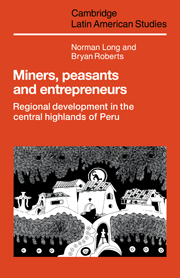Book contents
- Frontmatter
- Contents
- List of tables
- List of figures
- List of maps
- Preface
- 1 Regional development in an export economy
- 2 The development of a regional economy in the central highlands
- 3 The Mining Corporation and regional development
- 4 Class relations, local economies and large-scale mining
- 5 Highland puna communities and the impact of the mining economy
- 6 Migration and social differentiation amongst Mantaro valley peasants
- 7 Industrialization and the emergence of an informal regional economy
- 8 The village economy, agricultural development and contemporary patterns of social differentiation
- 9 Regional commitment among central highlands migrants in Lima
- 10 Confederations of households: extended domestic enterprises in city and country
- 11 Regional development in peripheral economies
- Notes
- Bibliography
- Index
- Titles in the series
9 - Regional commitment among central highlands migrants in Lima
Published online by Cambridge University Press: 07 May 2010
- Frontmatter
- Contents
- List of tables
- List of figures
- List of maps
- Preface
- 1 Regional development in an export economy
- 2 The development of a regional economy in the central highlands
- 3 The Mining Corporation and regional development
- 4 Class relations, local economies and large-scale mining
- 5 Highland puna communities and the impact of the mining economy
- 6 Migration and social differentiation amongst Mantaro valley peasants
- 7 Industrialization and the emergence of an informal regional economy
- 8 The village economy, agricultural development and contemporary patterns of social differentiation
- 9 Regional commitment among central highlands migrants in Lima
- 10 Confederations of households: extended domestic enterprises in city and country
- 11 Regional development in peripheral economies
- Notes
- Bibliography
- Index
- Titles in the series
Summary
The preceding chapters have emphasized the thriving nature of economic and social life in the central highlands which is based on a pattern of small-scale activities and considerable spatial mobility. This dynamic structure continues to exist in the face of increasing centralization of resources in the metropolitan area of Lima-Callao, generating, as was pointed out in chapter seven, a considerable return migration from Lima to the villages of the area and to the city of Huancayo.
Yet, despite this evidence of the region's capacity to retain and attract population, it is clear that, since the 1940s, there has been substantial out-migration and that most of this has been towards Lima. During the apogee of the agro-mining economy, labour migration to the mines and to the plantations was the predominant pattern. The surveys carried out by the project, in 1972, in the villages and in Huancayo itself showed, however, that this type of migration was increasingly replaced by direct migration to Lima (Roberts, 1973: 259; Samaniego, 1974: chapter VII). In this chapter, I look at a sample of migrants from the central highlands who now live in Lima, focussing, in particular, on the nature and significance of their ties with their area of origin.
A main aim of the chapter is to explore the implications of regional and village commitment for urban social life. In so doing, I hope to throw light on the nature of the interrelationships of metropolitan city and province in Peru, arguing that an integrated field of action has evolved in which the analytic distinction between rural and urban becomes redundant.
- Type
- Chapter
- Information
- Miners, Peasants and EntrepreneursRegional Development in the Central Highlands of Peru, pp. 198 - 216Publisher: Cambridge University PressPrint publication year: 1984
- 15
- Cited by



